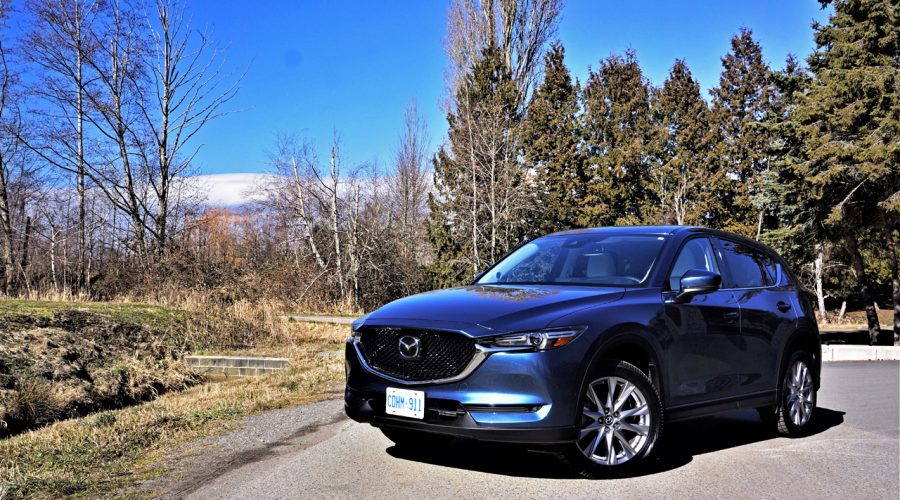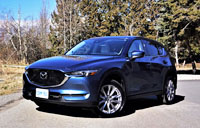
Mazda is doing a good job of taking its brand as close to premium territory as it can without actually raising prices to the point where it has to compete directly with Audi, BMW, Mercedes and the rest of the luxury labeled lot.
It starts with good outward design that translates well into all sizes and body styles, the sporty CX-3 subcompact SUV looking very similar to the fresh new CX-30, as well as the compact CX-5 shown here, and largest three-row CX-9 mid-size model, and likewise for the compact 3 and mid-size 6 series car lineup, not to mention the fabulous MX-5 sports car.
Mazda calls its latest design language KODO 2.0, or in other words this is now the second-generation of its clean and elegant “art of the car” philosophy, a glimpse of which we initially saw in its sensational Vision Coupe and Kai concepts from the 2017 Tokyo Motor Show, the latter of which more or less morphed into the latest Mazda3 Sport, and is starting to affect the brand’s SUVs like this recently updated CX-5.
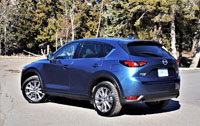
The CX-5 has been Mazda’s compact crossover utility since it laid its Ford Escape-based Tribute to rest in 2011, the much more modern Mazda3-based design arriving in January of 2012. The second-generation model seen here came onto the scene in 2017 and integrated much more KODO 2.0 styling into its design than its predecessor, resulting in a much more upscale looking SUV.
The real premium experience happens inside, however, with details like fabric-wrapped A-pillars and a luxuriously padded dash top, upper and lower instrument panel, and door uppers front to back, and then going so far as to trim out the cabin with a tasteful supply of anodized metal accents, this beautifully brushed treatment even decorating some of the switchgear that’s sometimes finished with knurled metal detailing, not to mention real Abachi hardwood in its top-tier Signature trim line. Mine didn’t include the Signature’s dark chocolate brown Cocoa Nappa leather and trim, the latter included on the door inserts and armrests along with the seats, but its Pure White regular leather was impressive nonetheless. It all makes for a rich, upscale environment.
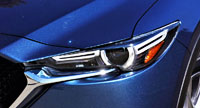
To be clear, despite the luxurious appointments seen inside the SUV in the photos, it isn’t a Signature model, but even this mid-range (third-rung out of four) GT trim line is nicer inside than most competitors top-line trims, albeit devoid of over-the-top premium bits like the Signature’s aforementioned wood inlays that adorn the instrument and door panels, plus the satin chrome-plated glove box lever and power seat switches, higher end cross-stitching detail on the steering wheel, plusher Nappa leather upholstery, a black interior roof lining, a frameless auto-dimming rearview mirror instead of a less elegant framed one, LED illumination for the overhead console lights, vanity mirrors, front and rear room lamps and cargo area light, and a host of upscale features like a nice bright 7.0-inch LCD multi-information display at centre, a one-inch larger 8.0-inch colour touchscreen display, a 360-degree surround parking monitor, front and rear parking sensors, gunmetal finish 19-inch alloy wheels in place of the GT’s silver-finish 19s, an off-road traction assist function to improve its ability on the trail, and the quickest Skyactiv-G 2.5 T four-cylinder engine featuring a Dynamic Pressure Turbo (DPT) good for 250 horsepower (with 93 octane premium fuel or 227 with 87 octane regular) and 310 lb-ft of torque (for 2020 it gains 10 lb-ft to 320 when fuelled with 93 octane), plus paddles for the six-speed automatic transmission.
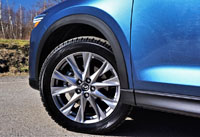
That’s a really potent powertrain for this class and available optionally for $2,000 in as-tested GT trim (for 2020 the GT with the turbocharged engine also gets paddles, off-road traction assist, and an 8.0-inch colour touchscreen display), although my tester came with the base non-turbo Skyactiv-G 2.5 four-cylinder with fuel-saving cylinder deactivation and no paddles on the steering wheel. So equipped it makes 187 horsepower and 186 lb-ft of torque, which is around the same as offered by the class sales leaders with their most formidable engines, while I prefer the feel of a regular automatic over those competitors’ continuously variable transmissions (CVT) any day of the week.
Of note, Mazda also offers a 2.2-litre four-cylinder turbo-diesel powerplant in top-line Signature trim that puts out 168 horsepower and 290 lb-ft of torque, the ritziest CX-5 starting at $40,950 (plus freight and fees) and topping out at $45,950 with the oil burner upgrade, so you’ll need to get the calculator out to see how long it’ll take to save $5,000 by using normally cheaper, more efficient diesel fuel. Before you do, however, make sure you check around for available examples, as the diesel feature was only available for the 2019 model year (at the time of writing there were plenty, albeit nowhere near as many as gasoline-powered variants).
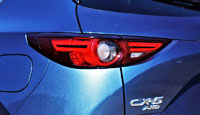
I tested it and was impressed, but as much as I like Rudolf’s invention and was plenty happy with its 8.9 L/100km city, 7.9 highway and 8.4 combined fuel economy, the much less expensive, and much quicker turbo-four achieves a very respectable claimed 10.8 city, 8.7 highway and 9.8 combined rating as it is, so it’s no wonder the diesel was discontinued. My GT tester, which comes standard with i-Activ all-wheel drive (AWD) and starts at $37,450, is good for 9.8, 7.9 and 9.0 respectively, while the same engine with FWD that comes standard with mid-range $30,750 GS trim is most efficient with a respective rating of 9.3, 7.6 and 8.5.
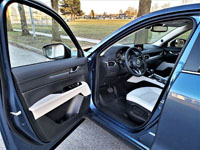
Believe it or not there’s a fourth engine available, the 2.5-litre four found in the $27,850 base GX without cylinder deactivation, which performs just as well yet manages just 9.7 L/100km in the city, 7.8 on the highway and 8.8 combined with FWD, whereas that engine with AWD is said to consume 10.2 city, 8.2 highway and 9.3 combined. AWD is a $2,000 option in GX and GS trims, by the way, and standard with the GT and Signature.
There’s absolutely no way I’m going to itemize every feature available in each trim, not to mention the various packages, but being that I tested the GT I should go over its standard kit. Features specific to the GT that can’t be found in lesser trims (yet come standard with the Signature) include the aforementioned 19-inch alloys on 225/55 all-seasons (lower trims include 17-inch alloys on 225/65s), adaptive cornering for the headlamps, LED signatures within the headlights and taillights, LED fog lamps, LED combination tail lamps, power-folding side mirrors, plus piano black B- and C-pillar garnishes, and that’s only on the outside.
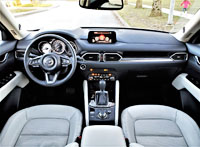
Proximity-sensing access lets you inside and pushbutton ignition gets things started (although the latter is standard across the line), while the primary instrument cluster is Mazda’s classic three-gauge design with a decent sized multi-information display in the right-side dial (the 7.0-inch LCD MID is standard in GT trim for 2020), and above that a really handy windshield-projected colour Active Driving Display (ADD) (head-up display) comes complete with traffic sign recognition. Additionally, a 10-way power-adjustable driver’s seat includes power lumbar support and two-way memory, while a six-way power-adjustable passenger’s seat is included too, as are three-way ventilated front seats, and three-way heatable rear outboard seats.
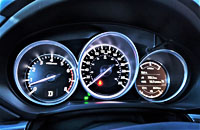
Back to premium-level niceties, a satin-chrome front console knee pad adds class to the front seating area, as does a fabric-lined glove box and premium stitching on the front centre console, while a powered moonroof adds natural light, a Homelink universal garage door opener adds convenience, accurate navigation got me where I was going, and a 10-speaker Bose audio system upgrade sounded great thanks to an AM/FM/HD radio, seven channels of customized equalization, SurroundStage Signal Processing, Centerpoint 2 surround sound technology, AudioPilot 2 Noise Compensation, and SiriusXM satellite radio (with a three-month complimentary service). Mazda also supplies CX-5 GT and Signature owners with SiriusXM Traffic Plus and Travel Link services (with a five-year complimentary service), as well as dual-zone automatic climate control, air vents on the backside of the front console, and more.

Some other features pulled up to the GT from lower trims include automatic headlight levelling, a front wiper de-icer, radar cruise control with stop and go, a heatable steering wheel, an additional two USB ports in the rear centre armrest, and a bevy of advanced driver assistive systems such as Smart Brake Support (SBS) with forward sensing Pedestrian Detection, Distance Recognition Support System (DRSS), Forward Obstruction Warning (FOW), Lane Departure Warning System (LDWS), Lane-keep Assist System (LAS) and High Beam Control System (HBC) from second-rung GS trim, plus auto on/off LED headlights and LED daytime running lights, LED turn signal indicators on door mirrors, rain-sensing intermittent wipers, an electronic parking brake, dual USB ports and an auxiliary audio input, Apple CarPlay and Android Auto, Aha and Stitcher internet radio, SMS text messaging read and respond function, as well as all the expected active and passive safety systems from the base GX. There’s plenty more, but I’ll leave something for you to discover.
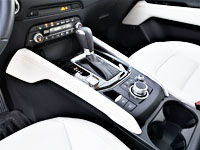
The CX-5 is spacious and comfortable no matter which trim you purchase, with excellent front and rear seating, including ample room for three abreast in the rear row. Legroom and headroom is good too, while the rear outboard heaters are a nice touch, although the controls can’t be accessed if someone’s sitting in the middle position. Now that I’m griping, a bright and airy panoramic sunroof would be welcome in top-tier GT and Signature models.
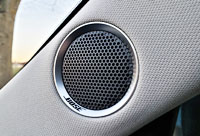
More important than that is the CX-5’s best-in-class 40/20/40 split folding rear seatbacks with convenient cargo sidewall-mounted release levers. I’m always calling for a centre pass-through and this is an even better solution, because there’s more than enough room for an entire family’s skis, poles and snowboards down the middle while boots, helmets and other gear is stowed in back with rear passengers comfortably occupying each window seat. Once again I bring up the folly of housing the rear seat warming buttons within the folding armrest, where they can’t be accessed when the centre pass-through is lowered. Hopefully Mazda will rethink this decision and relocate the rear seat heater switchgear to the door panels when the model comes up for redesign. On the positive, the CX-5 can load up to 875 litres (30.9 cubic feet) of cargo behind the rear seatbacks and 1,687 litres (59.6 cu ft) when they’re loaded flat, making it one of the roomier compact crossovers in its mainstream volume-branded class.
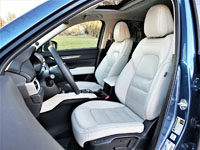
Mazda tops off all this roomy luxury with performance that comes very close to premium as well, although in my base GT tester I’m not referring specifically to straight-line power as much as ride and handling. The sense of quality starts with well-insulated doors and body panels, so that everything is solid feeling upon closure and nice and quiet once underway, while the ride is firm but never harsh, more akin to an Audi or BMW than a Mercedes or Lexus. Still, that translates into good manoeuvrability around town and better than average agility when pushed hard. Mazda relies on tried and tested engineering to achieve these results, its front suspension made up of MacPherson struts with coil springs and stabilizer bar, and its rear suspension incorporating an independent multi-link setup with coil springs and stabilizer bar.
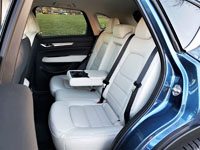
As noted earlier, the base engine is on par with some of the class leaders’ top powerplants as far as acceleration goes, but more importantly it’s smooth and efficient, while the six-speed automatic transmission was so smooth it made me wonder if Mazda hadn’t adopted a CVT into its drivetrain. Of course, it shifts like a regular automatic when revs climb, and while this is a very good thing that performance fans will appreciate, it once again goes about its business smoothly. While the base GT doesn’t offer paddles, you can shift manually via its console-mounted gear lever, and take note Mazda does provide a Sport mode that certainly gives it more pop off the line and better passing performance, but that’s it for extra drive settings, the default mode taking care of any eco and comfort duties that a driver might otherwise want to select.
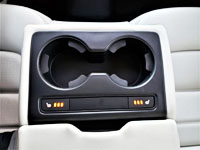
In summary, the 2019 Mazda CX-5 is an exceptionally good entry that should be considered seriously by anyone purchasing in its compact SUV class. The Canadian segment leader is Toyota’s RAV4 with a category-best 65,248 sales in calendar year 2019, followed closely by Honda’s CR-V with 55,859 deliveries, Ford’s Escape (all-new for 2020) at 39,504, Nissan’s Rogue at 37,530, Hyundai’s Tucson at 30,075, and the CX-5 at 27,696 unit sales. While the CX-5 might seem far down the list at first glance, keep in mind there are 14 entries in this class, and the next best-selling VW Tiguan only managed 19,250 deliveries, while the Chevrolet Equinox found just 18,503 buyers, Jeep Cherokee just 13,687, Subaru Forester only 13,059, Kia Sportage 12,637, GMC Terrain 12,023, Mitsubishi Outlander 10,701, and Mitsubishi Eclipse Cross 5,101 unit sales. What’s more, the CX-5 was one of just six models to increase its numbers year-over-year, the rest losing ground.
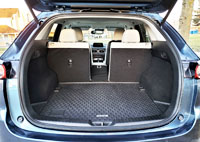
Right now is a good time to buy a CX-5, because Mazda is offering up to $2,000 in additional incentives on 2019 models (and plenty of 2019s are available right across Canada), and for those wanting a 2020 CX-5, up to $1,000 in incentives. Make sure to check CarCostCanada for all the details, including itemized pricing of trims, packages and individual options, manufacturer financing/leasing deals, rebate information, and otherwise hard to get dealer invoice pricing that can help you negotiate the best possible deal. Most retailers are available by phone or online, and of course they’re motivated to sell.
All said I highly recommend the CX-5 in this class, especially for those who appreciate the finer things in life, yet would rather not have to pay a premium price.

